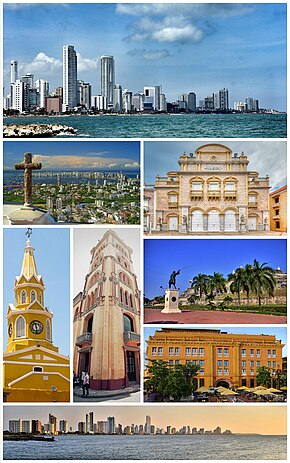
Back Cartagena de Indias ACE Cartagena, Colombia Afrikaans Cartagena de Indias ANG قرطاجنة (كولومبيا) Arabic كارتاهينا ARZ Cartagena de Indias AST Cartagena de Indias AVK Kartexena (Kolumbiya) Azerbaijani Cartagena de Indias BAR Картахена (Калумбія) Byelorussian
Cartagena | |
|---|---|
District and city | |
| Cartagena de Indias | |
 Top: Bocagrande Harbor. Second row: View of Santa Cruz Manga Island, Heredia Theatre. Third row: ClockTower (Torre del Reloj), Cloister of San Agustín (University of Cartagena), San Felipe Barajas Castle (Castillo de San Felipe de Barajas) (above), Charleston Hotel (below). Bottom: City Skyline. | |
| Nicknames: La ciudad mágica (The Magic City) La ciudad cosmopolita (The Cosmopolitan City) La heroica (The Heroic) El corralito de piedra (The Rock Corral) La fantástica (The Fantastic) | |
| Motto: "Por Cartagena" | |
 | |
| Coordinates: 10°24′N 75°30′W / 10.400°N 75.500°W | |
| Country | Colombia |
| Department | Bolívar |
| Region | Caribbean |
| Foundation | 1 June 1533 |
| Founded by | Pedro de Heredia |
| Named for | Cartagena, Spain |
| Government | |
| • Mayor | William Jorge Dau Chamat[1] |
| Area | |
• District and city | 83.2 km2 (32.1 sq mi) |
| • Metro | 597.7 km2 (230.8 sq mi) |
| Elevation | 2 m (7 ft) |
| Population (2020[3]) | |
• District and city | 914,552 |
| • Rank | Ranked 5th |
| • Density | 11,000/km2 (28,000/sq mi) |
| • Metro | 1,028,736[2] |
| • Metro density | 1,721/km2 (4,460/sq mi) |
| Demonym | Cartagenero(s) (in Spanish) |
| GDP (PPP, constant 2015 values) | |
| • Year | 2023 |
| • Total | $17.1 billion[4] |
| • Per capita | $15,600 |
| Time zone | UTC-5 (COT) |
| Postal code | 130000 |
| Area code | 57 + 5 |
| Patron saints | Saint Catherine and Saint Sebastian |
| Average temperature | 30 °C (86 °F) |
| City tree | Arecaceae |
| Website | www |
| Official name | Port, Fortresses and Group of Monuments, Cartagena |
| Type | Cultural |
| Criteria | iv, vi |
| Designated | 1984 (8th session) |
| Reference no. | 285 |
| Region | Latin America and Caribbean |
Cartagena (/ˌkɑːrtəˈheɪnə/ KAR-tə-HAY-nə), known since the colonial era as Cartagena de Indias (Spanish: [kaɾtaˈxena ðe ˈindjas] ⓘ), is a city and one of the major ports on the northern coast of Colombia in the Caribbean Coast Region, along the Caribbean Sea. Cartagena's past role as a link in the route to the West Indies provides it with important historical value for world exploration and preservation of heritage from the great commercial maritime routes.[5] As a former Spanish colony, it was a key port for the export of Bolivian silver to Spain and for the import of enslaved Africans under the asiento system. It was defensible against pirate attacks in the Caribbean.[6] The city's strategic location between the Magdalena and Sinú rivers also gave it easy access to the interior of New Granada and made it a main port for trade between Spain and its overseas empire, establishing its importance by the early 1540s.
Modern Cartagena is the capital of the Bolívar Department, and had a population of 876,885 according to the 2018 census,[7] making it the second-largest city in the Caribbean region, after Barranquilla, and the fifth-largest city in Colombia. The metropolitan area of Cartagena is the sixth-largest urban area in the country, after metropolitan area of Bucaramanga. Economic activities include the maritime and petrochemical industries, as well as tourism.
The present city—named after Cartagena, Spain and by extension, the historic city of Carthage—was founded on 1 June 1533, making it one of South America's oldest colonial cities;[8] but settlement by various indigenous people in the region around Cartagena Bay dates from 4000 BC. During the Spanish colonial period Cartagena had a key role in administration and expansion of the Spanish empire. It was a center of political, ecclesiastical, and economic activity.[9] In 1984, Cartagena's colonial walled city and fortress were designated a UNESCO World Heritage Site.
It was also the site of the Battle of Cartagena de Indias in 1741 during the War of Jenkins' Ear between Spain and Britain.
- ^ Batista, Lia Miranda (1 January 2020). "William Dau Chamatt se posesionó como nuevo alcalde de Cartagena" [William Dau Chamatt Takes Office As the New Mayor of Cartagena]. El Universal (in Spanish). Retrieved 2 January 2020.
- ^ "Proyecciones de Población 2018–2020, total municipal por área (estimate)". DANE. Archived from the original on 23 February 2020. Retrieved 23 February 2020.
- ^ Proyecciones de Población 2018–2020, total municipal por área. DANE (Report) (in Spanish). 2020. Archived from the original on 23 February 2020. Retrieved 23 February 2020.
- ^ "TelluBase—Colombia Fact Sheet (Tellusant Public Service Series)" (PDF). Tellusant. Retrieved 11 January 2024.
- ^ Centre, UNESCO World Heritage. "Port, Fortresses and Group of Monuments, Cartagena". UNESCO World Heritage Centre.
- ^ Lance R. Grahn, "Cartagena" in Encyclopedia of Latin American History and Culture, vol. 1, p 581. New York: Charles Scribner's Sons 1996.
- ^ Citypopulation.de
- ^ "Big on Charm: Colonial Cartagena". Travel. 17 November 2015.
- ^ Grahn, "Cartagena" p. 582.



